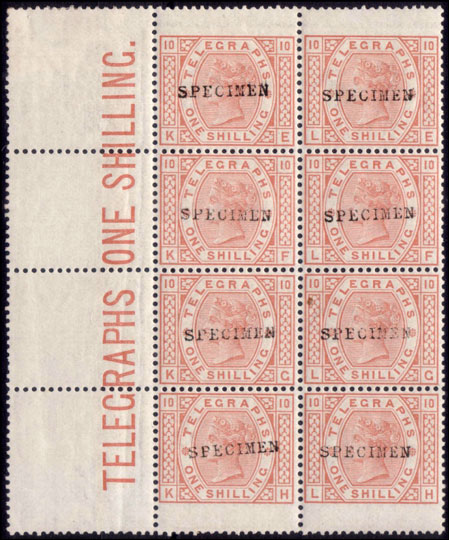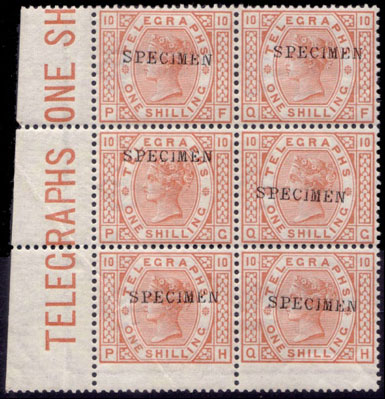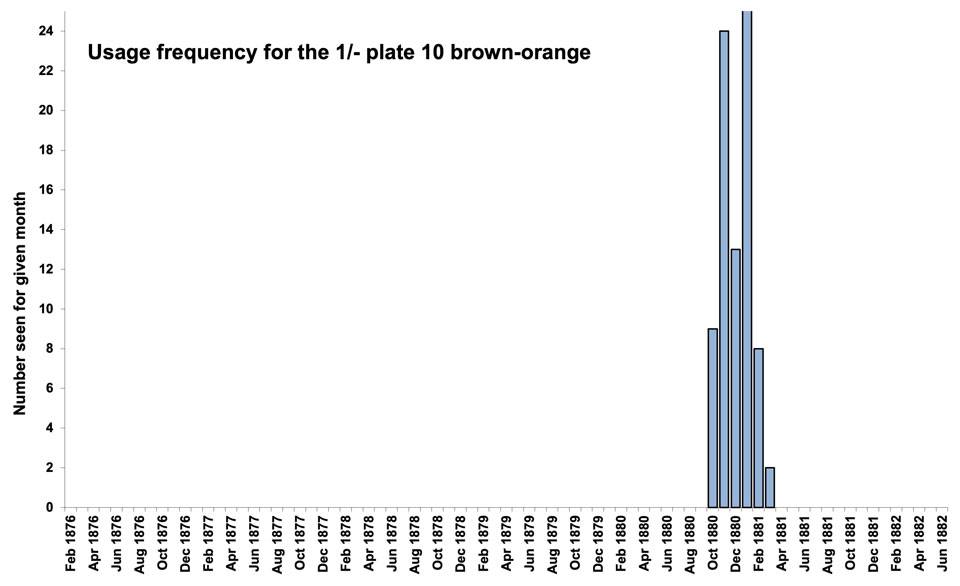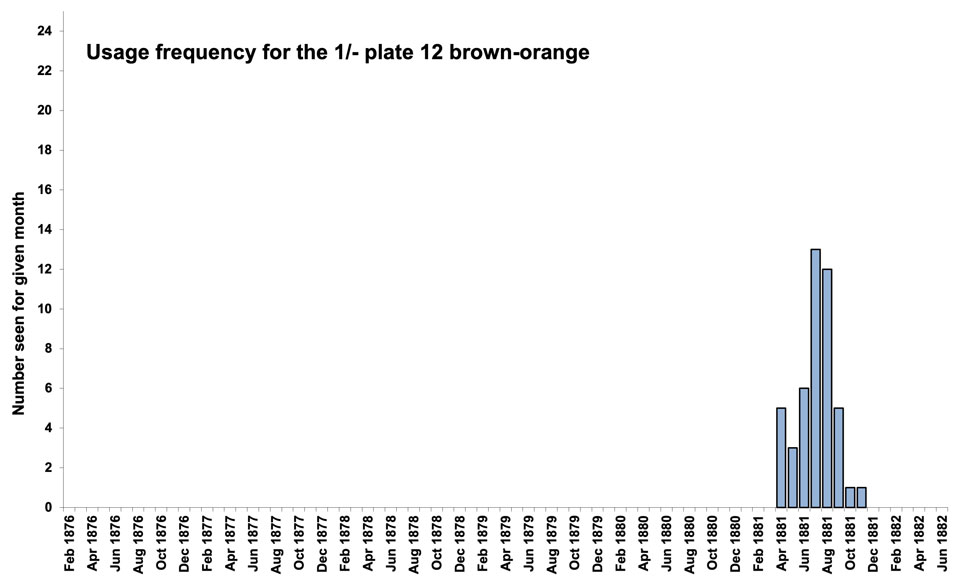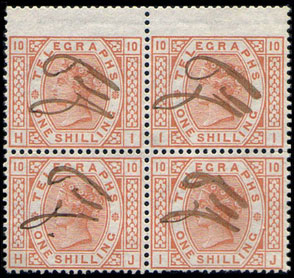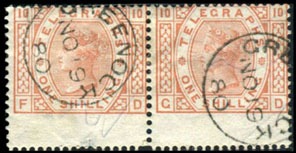1 Essays
2 Die Proofs
3 Sheet Layout
4 Plate Proofs
5 Paper
6 Imprimaturs
7 Colour Standards
8 Specimens
9 Issued Stamps
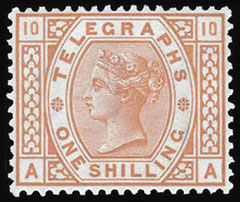
Date: Oct 1880
Plates: 10-12
Printer: De La Rue
Watermark: Spray (sideways)
Perforation: 14
In a Post Office circular of 21 Sept 1880 it was announced that the 1s postage stamp was to be changed from green to brown so as not to be confused with the ½d green postage stamp planned for issue on 14 October 1880 (the “Provisional” issue). As telegraph and postage stamps of the same value were to be printed in the same colour, the 1s Post Office Telegraphs colour had to be changed at the same time. The colour is variously referred to as brown-orange, salmon, pale red-brown and orange-brown in the literature. The De La Rue ink recipe for “1/- English Postage” describes the colour as “Italian Brown”.
Since this was a change of colour, there are no essays or die proofs.
Sheet Layout
The sheet had 240 stamps in 12 panes, arranged as three rows of four. Each pane had 20 stamps in four rows of five. To the left of each pane reading upwards was “TELEGRAPHS ONE SHILLING.”. Plate numbers were in the upper left and lower right corners, current numbers in the lower left and upper right corners, all reading upwards. At the middle of each side was a cross used as a perforating guide.
A Post Office sheet was one pane, valued at one pound.
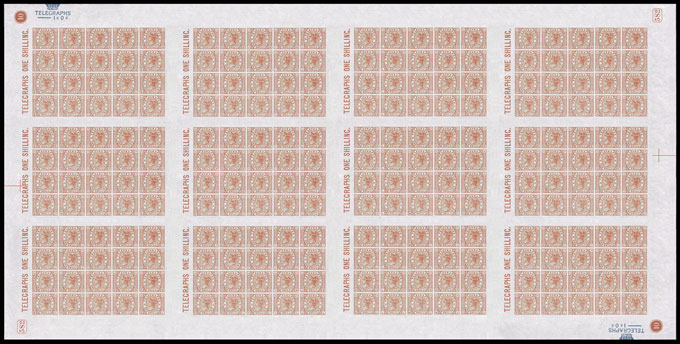
Computer generated image, click to enlarge.
Plate Proofs
There are no plate proofs for the change of colour.
Paper
The 1s brown-orange was initially printed on the same paper as the 1s green. It was printed on Spray of Rose paper.
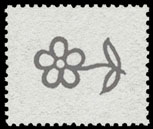
The watermark as seen from the front of the stamp.
For more details on Spray paper click here.
Imprimaturs
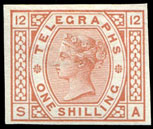
Plate 12 was re-registered on 14 Feb 1881.
The sheet was endorsed “Proof for change of colour.” and
“Ordered that stamps of this colour be brought into use.”
The registration sheets for the Telegraphs have been lost. However, we can reconstruct them from known examples and a clear pattern emerges. Most have a column of 12 taken, plus four from the adjacent column, and a plate number example from the opposite corner. One sheet of each value has an extra column of 12 taken.
Red represents an institutionalised example.
Green a known example in private hands.
Blue is unknown but predicted by the pattern.
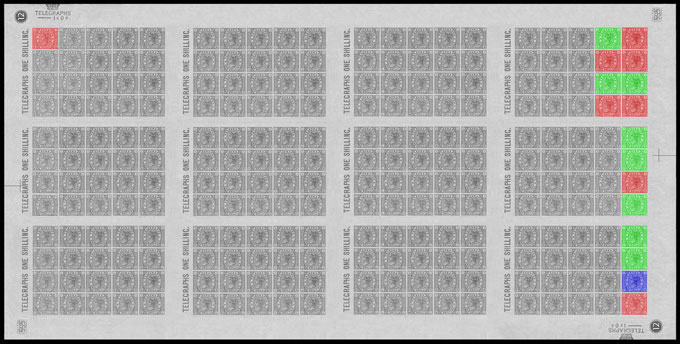
| Institutionalised/Total: | 8/17 |
| Royal Philatelic Collection: | AA, TL |
| British Postal Museum: | SB, SD |
| Tapling Collection: | TG |
| Langmead Collection: | TA |
| Phillips Collection: | TB, TD |
Colour Standards
No colour standard sheet has been identified for the 1s Brown-orange, but it could be the perforated sheet overprinted Specimen Type 9e below.
Specimens
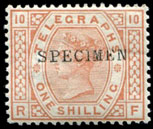
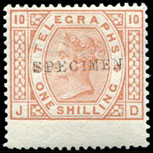
Plate 10 Type 9: scarce, from 5 panes (PE-TH x5), 4 pairs and blocks of 4 (x2) and 6 known.
Plate 10 Type 9e: scarce, from one complete sheet, 3 pairs, a strip of 3, and blocks of 4 (x4) and 8 known.
This is the only telegraph stamp overprinted with Type 9e.
Click the images to enlarge.
Reference to scarcity, blocks and the number of sheets or panes so treated is derived from reconstructions of known examples within our database.
Issued Stamps
Stamps were issued from plates 10 and 12.
The usage frequency graphs show that plate 10 was used from Oct 1880 and then plate 12 from Apr 1881.
Click the graphs to enlarge.

Postal usage is rare. A duplex, an A06 (British Honduras), and two fakes are known to us.

Three singles and a block of four fiscal usage, and only 642 & 1097 “English Station” and 83 & 161 “Scottish Station” railway numerals are known to us. Plate 12 with 161 is in the Phillips Collection.
Issued Stamps — Plate 10
Plate 10 (current no. 582) was registered on 19 Sept 1879 in green and put to press on 2 Feb 1880. The colour was changed to brown-orange after printing about 13,000 sheets in green. It was taken from press on 6 Oct 1880 after printing about 50,000 sheets in brown-orange.
Scarcity #19 in mint telegraphs, #28 in used telegraphs.
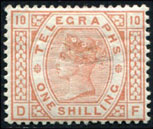
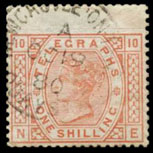
No mint multiples are known to us other than a block of four in the Phillips Collection. A pair recently sold at auction has since been split.
Used stamps are scarce with a block of four (used fiscally) and two pairs in the database. The earliest known used example is 19 Oct 1880 at Newcastle on Tyne, Quayside (illustrated).
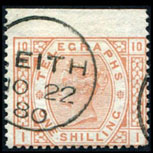
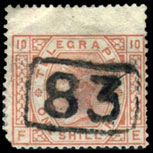
Wing margins exist guillotined or perforated, the same as the 1s orange-brown plate 13 and 8d orange plate 1 postage stamps.
No inverted watermarks are known to us.
Click the images to enlarge.
Issued Stamps — Plate 11
Plate 11 (current no. 589) was registered on 13 May 1880 in green.
Wright and Creeke say “Plate 11 is stated to have been put to press on 6 December 1880, but no copies in pale red-brown, on the spray of rose paper, have been met with”.
We share their doubt and think that none were printed, especially as the earliest known used example for this plate on Crown is now 13 Jan 1881.
Issued Stamps — Plate 12
Plate 12 (current no. 595) was registered on 15 July 1880 in green.
It was re-registered on 14 Feb 1881 in brown-orange.
Scarcity #27 in mint telegraphs, #35 in used telegraphs.
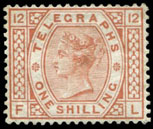
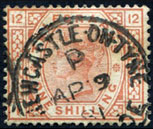
Mint stamps are rare. No mint multiples are known to us.
Used stamps are rare with no used multiples known to us. The earliest known used example is 9 Apr 1881 at Newcastle on Tyne, Quayside (illustrated).
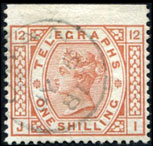
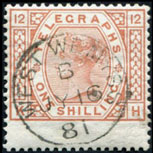
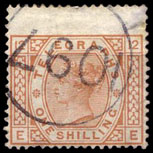
Wing margins exist guillotined or perforated, the same as the 1s orange-brown plate 13 and 8d orange plate 1 postage stamps.
No inverted watermarks are known to us.
